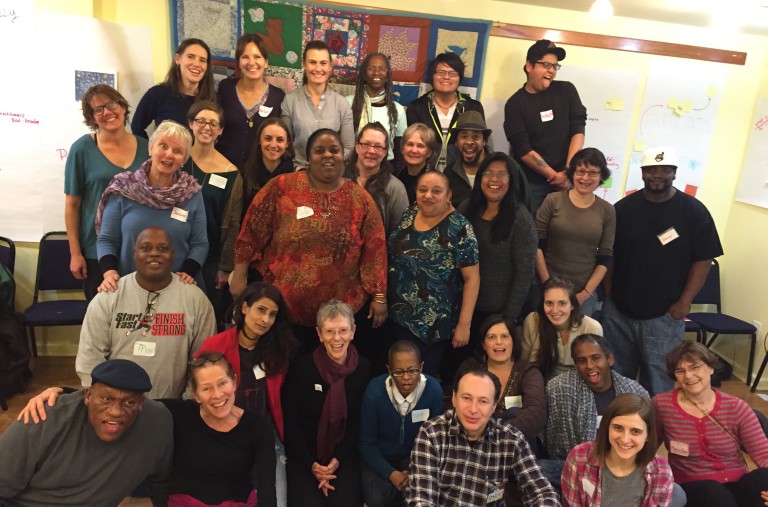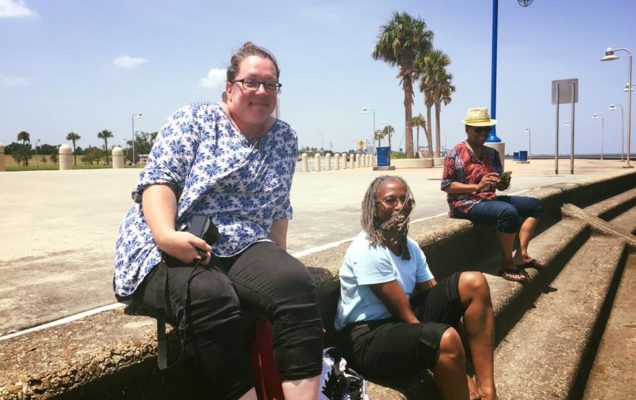People in Poverty Challenge Researchers to Define Poverty with Them

Above: MAP facilitators and participants during the training weekend in December 2016.
How many poor people are there in the world? How many are “lifted out of poverty” by development programs? Is $1.90 a day a good measure if you live in a developed country? Does free food count as income? Are you still poor if you have $1.90/day but no access to clean water or health care? What is poverty?
These are some of the questions economists and statisticians ask when they talk about measuring poverty. But what do people who actually live in poverty say about defining and measuring it? ATD is answering this question with a three-year international research project on poverty indicators. Maryann Broxton, a coordinator with the National Research Team in the U.S., highlights the meaning and impact of this work for her personally and for those involved in poverty eradication efforts.
Importance & Meaning
MAP [Multidimensional Aspects of Poverty*] is important because usually when people study poverty, they study people. Usually it’s professional researchers who have a degree, such as sociologists, psychologists, economists, and statisticians. They observe people as subjects. They find out the information from them and interpret into what they think is important, then tell a story.
This project is the complete opposite. In this project, people with lived experience of poverty are involved from the beginning to the end. We are on the US Research Team; we do outreach, organize, and facilitate peer groups; we design the project and activities that are used to determine the dimensions. We review and help create the US findings report. From there, we will create the international report.
There are only three dimensions in the current Multidimensional Poverty Index (MPI). We know there are more than that. I use this story that Shawn [member of the National Research Team] told. When he was growing up there was no water around. But everybody was like that, so you didn’t measure a lack of water as poverty. You measured poverty by how much violence you had experienced. Violence isn’t one of the dimensions on the MPI list. So you can see right there why this is so important.

Knowledge Brought to the Table
I’ve always lived in poverty. Just even with the federal poverty line, below it or just a bit above it. It’s been that way whether I worked full-time or wasn’t working full-time. So I bring that life experience to it. I bring experiences of surviving as a single parent and how to navigate that. I also graduated recently, so I have the academic side of the knowledge as well.
The idea of this project is to bring people with you in the journey and help them teach you. They learn from your skills, you learn from their skills, so you can both go forward, and then teach the person behind to come with you. That’s basically what I see this is, a Merging of Knowledge. I know I’m privileged because I did get to go to school and meet different people, but some people don’t get to do that. Some people live in their own bubbles, even academics and practitioners, because they only know people with lived experiences of poverty as their clients, patients, or students. They have only had those interactions. Coming together changes the way you think, the way you see the world.
Personal & Community Impacts
This is empowering. This is all about us getting together and saying that we’re going to act. The more of us together, the stronger our voice is. I think it’s amazing to see people doing things that they never thought they could do. To see this coming out in large scale of people getting together and thinking – yes, I can do this – is very nice.
What we like about this project here in the US, is that there are two levels. Yes, when it’s completed three years from now, its findings will go to the World Bank and the United Nations, but that’s long-term. Each research group location is also going to get a copy of the report so they can advocate for themselves. I think that’s going to be a wonderful thing that will come out of this. To see that people who want to advocate, but don’t know how, they can say that this is true and here’s the paper to back it up.
In a way we’re giving people a tool but they’re creating it themselves. They’re creating the documentation that can actually change their environment and surroundings.
*Multidimensional Aspects of Poverty in the United States is being conducted in partnership with the University of New Mexico, Gallup North Campus and Oxford University in England.
This article was originally published here on the U.S. ATD Fourth World site.
More information on the International Measures of Poverty Project.
More information on ATD Fourth World’s participatory research.

